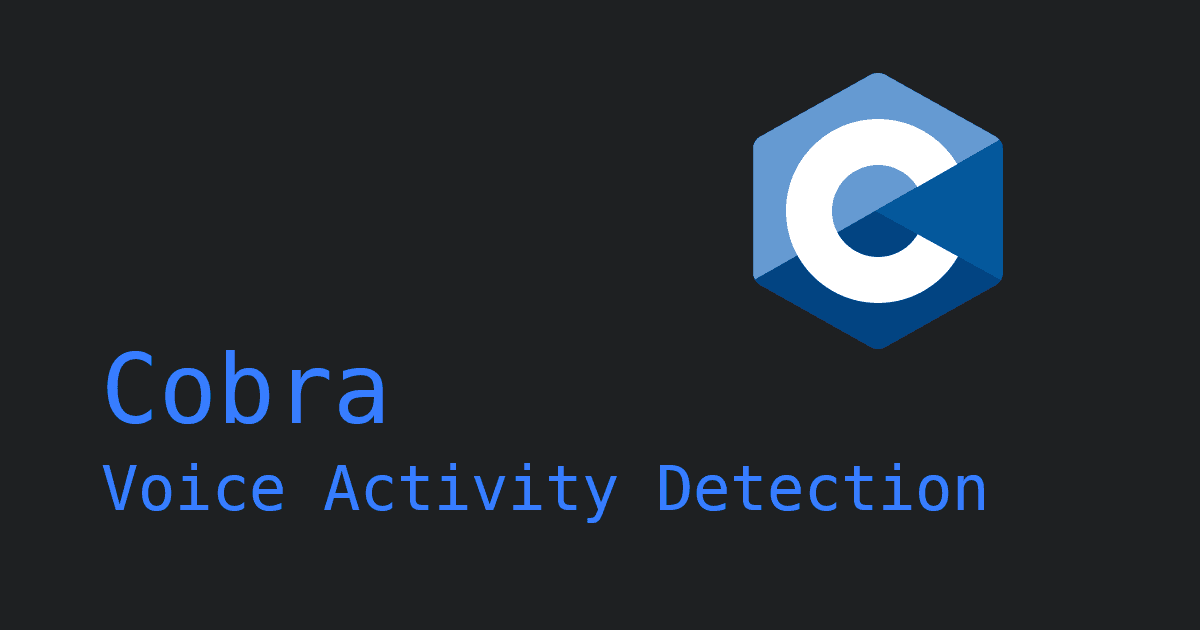Voice Activity Detection (VAD) is the foundation of modern voice AI — it determines when someone is speaking and when there's silence. It powers everything from video conferencing and real-time transcription to wake word and speech recognition systems.
Choosing the right VAD engine directly impacts user experience, accuracy, and efficiency of applications. In 2025, the three most popular options are WebRTC VAD (Google's open-source engine), Silero VAD (newer open-source deep learning model), and Cobra VAD from Picovoice (production-ready, lightweight deep learning VAD)
This guide compares the accuracy, performance, SDK support, and production readiness of these 3 VAD alternatives to help you pick the best VAD for your application.
Table of Contents
WebRTC VAD Overview
What is WebRTC VAD?
WebRTC VAD is an open-source voice activity detection engine developed as part of Google's WebRTC project. It is lightweight, simple, and widely used.
How WebRTC VAD Works
WebRTC VAD uses traditional signal processing techniques based on Gaussian Mixture Models (GMM). It analyzes acoustic features, including energy levels, spectral characteristics, zero-crossing rates, and pitch information, to make binary decisions (speech vs. no-speech) using hand-crafted rules.
WebRTC VAD Highlights and Considerations
Highlights:
- Extremely lightweight with minimal CPU and memory footprint
- No dependencies - pure C implementation
- Free, open-source, and well-documented
- Battle-tested and used by millions in WebRTC applications
Considerations:
- Low accuracy, especially in noisy conditions
- Legacy signal processing rather than modern machine learning
- Limited noise robustness - Struggles with babble noise, music, and non-stationary noise
- Primarily web-focused; platform support is limited
Silero VAD Overview
What is Silero VAD?
Silero VAD is an open-source, deep learning-based engine released in 2021. It provides high accuracy in complex audio environments. Heavy for power-constrained (mobile) devices, mainly due to its PyTorch/ONNX dependency.
How Silero VAD Works
Silero VAD uses deep neural networks implemented in PyTorch to classify audio frames. Silero VAD is trained on huge corpora that include over 6,000 languages, though the architecture details (layer counts, exact topology), training regime (epochs, loss function, augmentation strategy), and exact dataset(s) used for training or dataset details (names, size, languages, annotations) are not publicly disclosed. The model outputs probability scores from 0 to 1, indicating the likelihood of speech presence.
Silero VAD Highlights and Considerations
Silero VAD is an open-source, deep learning–based voice activity detection engine, optimized for high accuracy in complex audio environments. It is best suited for powerful computers and machine learning enthusiasts.
Highlights:
- Higher accuracy than WebRTC, especially in noisy environments
- Deep learning approach that learns from data rather than hand-crafted rules
- Free and open-source
- Active development with regular updates from the maintainer
- Good documentation
Considerations:
- Requires PyTorch or ONNX (larger footprint, heavier runtime), optimization limitations
- Limited platform support - primarily Python
- No officially maintained mobile SDKs - requires ONNX export
- No enterprise support - maintainer & community support
Cobra VAD Overview
What is Cobra VAD?
Cobra VAD is a production-ready, cross-platform engine combining deep learning accuracy with lightweight performance. As a proprietary engine, it is suited for enterprise deployment rather than research customization.
How Cobra VAD Works
Cobra VAD uses Picovoice's proprietary deep neural networks trained on thousands of hours of audio across diverse conditions. Key technical features include a custom neural architecture for efficient on-device VAD, noise-robustness, real-time processing with minimal latency, and cross-platform native implementations while achieving industry-leading accuracy. The engine outputs probability scores, allowing fine-tuned threshold control.
Cobra VAD Highlights and Considerations
Cobra VAD is a production-ready, cross-platform engine combining deep learning accuracy with lightweight performance. Picovoice's proprietary, closed-source technology doesn't allow deep learning researchers to change the code.
Highlights:
- Highest accuracy - 2x better than WebRTC VAD
- Lightweight - Runs on Raspberry Pi Zero at 5% CPU usage
- True cross-platform support - Web, mobile, desktop, embedded, and server
- Built for enterprise deployment, not research
- Real-time performance with low latency, suitable for live applications
- Enterprise support with commercial backing and a dedicated support team
- Professional SDKs with native implementations for every major platform
Considerations:
- Requires AccessKey - available via Picovoice Console account
- Commercial license required for production use
Head-to-Head Comparison
Accuracy and Performance Comparison of VAD Engines
Accuracy is the most important factor for VAD. Poor accuracy leads to cut-off speech, wasted processing, and frustrated users.
Understanding ROC Curves for VAD Comparison
The ROC (Receiver Operating Characteristic) curve below compares WebRTC VAD, Silero VAD, and Cobra VAD by plotting True Positive Rate (TPR—percentage of speech correctly detected) against False Positive Rate (FPR—percentage of silence incorrectly detected as speech) across all possible detection thresholds.
Performance of VAD Engines at 5% False Positive Rate
At a 5% False Positive Rate (5 false activations per 100 non-speech frames):
- WebRTC VAD: 50% TPR — misses approximately 1 out of every 2 speech frames
- Silero VAD: 87.7% TPR — misses 1 out of 8 speech frames
- Cobra VAD: 98.9%TPR — misses 1 out of every 100 speech frames
Comparative accuracy at 5% FPR: Silero has 4x fewer errors than WebRTC, Cobra has 12x fewer errors than Silero, and Cobra has 50x fewer errors than WebRTC at 5% FPR.
Performance of VAD Engines at 1% False Positive Rate
At a stricter detection threshold - 1% False Positive Rate, the True Positive Rates for all engines change. The graph below shows a zoomed-in view of the ROC curve. [Note: WebRTC is excluded due to its extremely low TPR at this threshold.]
Performance of VAD Engines at 1% False Positive Rate
- Silero VAD: 80.4% TPR — misses 1 out of 5 speech frames.
- Cobra VAD: 95% TPR — misses 1 out of 20 speech frames.
Comparative accuracy at 1% FPR: Cobra has 4x fewer errors than Silero at 1% FPR.
Real-World Impact of VAD Engine Performance: Video Call Example
To illustrate the practical impact, consider a 1-hour video call with 30 minutes of actual speech (equivalent of 56,250 audio frames, where 1 audio frame represents 32 ms) at 5% FPR:
- WebRTC VAD: Detects 28,125 frames, misses 28,125 frames, resulting in approximately 62 speech cut-offs with frequent interruptions and a frustrating experience
- Silero VAD: Detects 49,500 frames, misses 6,750 frames, resulting in approximately 9-10 speech cut-offs with occasional interruptions, but generally good experience
- Cobra VAD: Detects approximately 55,688 frames, misses 562 frames, resulting in a cut-off or two, with rare interruptions and a smooth experience
Understanding Threshold Selection: Why AUC Matters
When comparing VAD engines, the choice of detection threshold (FPR operating point) significantly impacts results.
Comparison at 25% False Positive Rate:
It's established that Silero VAD is more accurate than WebRTC VAD at 5% and 1% False Positive Rates. However, at 25% FPR, TPR of WebRTC VAD is higher than TPR of Silero VAD - which means WebRTC VAD is more accurate than Silero VAD.
While enterprises can evaluate the engines at their preferred thresholds, scientists use AUC to compare the performance of engines across all thresholds. AUC refers to Area Under the Curve and summarizes performance comprehensively. The greater the AUC, the better the model accuracy is.
AUC Comparison of VAD Engines:
The larger the AUC, the better the engine performs across all possible detection thresholds, making it a reliable, vendor-neutral metric for VAD comparison.
- Cobra VAD: Largest AUC = most accurate
- Silero VAD: Medium AUC = better than WebRTC
- WebRTC VAD: Smallest AUC = lowest overall accuracy
Key Takeaway: Always evaluate VAD engines at your application's required FPR or compare using AUC to avoid misleading threshold-dependent claims.
Resource Efficiency Comparison
Real-time Factor (RTF) measures the computational time required to process audio. For example, on an Ubuntu machine with an AMD Ryzen 9 5900X CPU:
- Silero VAD (Python) measured an RTF of 0.004, which means
- Processing time: 15.4 seconds per hour of audio
- Real-time CPU usage: 0.43%
- Cobra VAD (C) measured an RTF of 0.0005, which means
- Processing time: 1.8 seconds per hour of audio
- Real-time CPU usage: 0.05%
While 0.43% CPU usage appears negligible on high-performance hardware, the efficiency gap becomes critical on resource-constrained devices. For example, the RTF value for Cobra VAD on Raspberry Pi Zero is 0.05, meaning that it uses about 5% of the CPU. The 8.6x difference becomes significantly important on the RPI Zero, as Silero VAD uses almost half of the CPU, making Silero unfit for low-computational power devices because voice applications typically require multiple components beyond VAD:
- Audio capture and preprocessing
- Speech recognition or wake word detection
- Natural language processing
Dedicating 43% of CPU resources to VAD alone leaves insufficient processing power for these other essential functions.
Optimization and Runtime Architecture
WebRTC VAD:
Pure C implementation with no runtime dependencies. Minimal overhead.
Silero VAD:
Requires PyTorch or ONNX Runtime, which are not designed for edge deployment, hence, carry significant runtime overhead. While ONNX provides some optimization, it's still adapting a general-purpose ML framework for embedded use with significant drawbacks.
Cobra VAD:
Custom-built for edge deployment from the ground up. Native implementations for each platform with no runtime dependencies. Optimized neural architecture specifically designed for resource-constrained devices, not a repurposed server model.
Why Runtime Architecture Matters
Every choice in the training and deployment processes, including neural network, quality of data, and runtime, affects the performance of voice AI engines. When built carefully, custom and dedicated solutions can provide significant efficiency advantages (lower memory usage, better battery life, more predictable performance) over workarounds and after-the-fact optimizations that squeeze server models.
Ease of Integration
WebRTC VAD Integration
Difficulty: Easy for web and C, Medium-Hard for other platforms
Integration steps: WebRTC VAD is part of the browser's WebRTC implementation, so it's readily available and easy to use in web applications. Manual integration of C source code or third-party wrappers for other platforms requires significant development effort.
Silero VAD Integration
Difficulty: Easy for Python, harder for other platforms
Integration steps: For simple integration, install PyTorch, load the Silero VAD model from torch.hub, prepare audio in the correct format, run inference, and parse results. For the rest, it requires ONNX export and runtime setup.
Cobra VAD Integration
Difficulty: Easy for all platforms
Integration steps: Install the Cobra SDK for your platform in minutes by getting a free AccessKey from Picovoice Console.
Maintenance and Support
WebRTC VAD Support: Maintained by Google as part of the WebRTC project with a large existing user base. However, there is no dedicated support and only community documentation available.
Silero VAD Support: Active open-source development with community support only. No SLA or guarantees, and dependent on the maintainer's availability.
Cobra VAD Support: Maintained by Picovoice with enterprise support available, regular updates and improvements, SLA guarantees, and dedicated engineering support for paid plans.
Licensing and Cost
WebRTC VAD License: BSD permissive open source license. Free and commercial use allowed.
Silero VAD License: MIT permissive open source license. Free and commercial use allowed.
Cobra VAD License: Non-commercial license with free plan and commercial license with free trial and paid plans.
Platform Support
VAD for Web Applications
- WebRTC VAD: Browser-native
- Silero VAD: Requires ONNX Runtime Web
- Cobra VAD: WebAssembly SDK
VAD for Mobile Applications
- WebRTC VAD: Native C bindings, manual adaptation
- Silero VAD: No official SDK, heavy for mobile
- Cobra VAD: Official iOS & Android SDKs
VAD for Desktop and Server Applications
- WebRTC VAD: Native in C/C++ implementation and other languages (e.g., Python) supported via community projects
- Silero VAD: Official support for Python, and other languages (e.g., Rust) supported via community projects
- Cobra VAD: Official support for Python, C, .NET, Node.js — production-ready
VAD for Microcontrollers (MCUs) and Microprocessors (MPUs)
- WebRTC VAD: Lightweight, but manual setup needed
- Silero VAD: Too heavy
- Cobra VAD: Optimized, ready for low-power deployment
Conclusion
For production-grade applications in 2025, Cobra VAD is the top choice for enterprises with: 99% accuracy, cross-platform SDKs, enterprise support, and low-latency, on-device processing. Silero VAD is great for research or Python-heavy environments, and WebRTC VAD is lightweight and easy for web projects.
Start free to see the Cobra VAD difference for yourself.
Start Free






